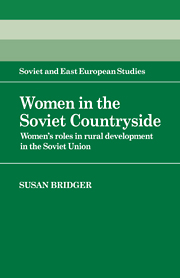Book contents
- Frontmatter
- Contents
- List of figures
- List of tables
- Acknowledgements
- Notes for readers
- Map: the Union republics of the USSR
- Map: the Non-Black Earth Zone of the RSFSR
- INTRODUCTION
- 1 WOMEN IN THE RURAL WORKFORCE
- 2 WOMEN IN THE RURAL FAMILY
- 3 WOMEN'S ROLES IN RURAL CULTURE
- CONCLUSIONS
- Notes
- Bibliography
- Index
CONCLUSIONS
Published online by Cambridge University Press: 05 January 2012
- Frontmatter
- Contents
- List of figures
- List of tables
- Acknowledgements
- Notes for readers
- Map: the Union republics of the USSR
- Map: the Non-Black Earth Zone of the RSFSR
- INTRODUCTION
- 1 WOMEN IN THE RURAL WORKFORCE
- 2 WOMEN IN THE RURAL FAMILY
- 3 WOMEN'S ROLES IN RURAL CULTURE
- CONCLUSIONS
- Notes
- Bibliography
- Index
Summary
On the eve of the socialist Revolution of 1917, the vast majority of Russia's population, its peasantry, had been free from the bonds of feudalism for less than sixty years. The mass of rural women lived out their lives under male authority within the hierarchical structures of the peasant family. Arranged marriage, difficult divorce and regular pregnancies were characteristic features of their personal lives. The primitive nature of peasant agriculture and the poverty of the former serf households placed heavy burdens on women whose work in subsistence farming and whose domestic labour were a major source of support for their families.
In the contemporary USSR the rural environment in which the descendants of these women live is very different. The world's first socialist state is now a major industrial power. Its agriculture is collectivised or state-run with many of its essential processes mechanised. Rural living standards have improved considerably, especially during the last twenty years. As the countryside has changed, rural women have themselves been transformed from the illiterate and downtrodden masses described by the activists and commentators of the 1920s. The old peasant family has vanished, and in the rural family of today, women are often better educated than their husbands and are regularly to be found taking the lead in decision making.
- Type
- Chapter
- Information
- Women in the Soviet CountrysideWomen's Roles in Rural Development in the Soviet Union, pp. 217 - 226Publisher: Cambridge University PressPrint publication year: 1987

